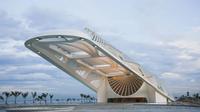Museum of Tomorrow Guided Visit and Transportation
Rio de Janeiro, Brazil
Trip Type: Cultural Tours
Duration: Flexible
The spectacular building designed by Santiago Calatrava is on a 15,000m sq area on the Pier Mauá that incorporates a huge reflective pool, gardens, and cycle paths. The main exhibition at the “Museum of Tomorrow” is the brainchild of physicist and cosmologist Luiz Alberto Oliveira, and takes visitors through five major areas: Cosmos, Earth, Anthropocene, Tomorrow and Now via a number of experiments and experiences, encouraging them to explore fundamental questions of existence and to envisage the kind of future we all face.
More About This Activity All Cultural Tours →
The spectacular building designed by Santiago Calatrava is on a 15,000m sq area on the Pier Mauá that incorporates a huge reflective pool, gardens, and cycle paths. The main exhibition at the “Museum of Tomorrow” is the brainchild of physicist and cosmologist Luiz Alberto Oliveira, and takes visitors through five major areas: Cosmos, Earth, Anthropocene, Tomorrow and Now via a number of experiments and experiences, encouraging them to explore fundamental questions of existence and to envisage the kind of future we all face.The city of Rio de Janeiro has opened a new “experimental museum” called the Museum of Tomorrow, on December 19th 2015, devoted to exploring the possibilities of a sustainable future through interactive artifacts that bring science, art, technology and culture together. It is housed in a magnificent spaceship-like building that is set to become the center-piece of a larger regeneration project of the Porto Maravilha neighborhood. The building’s most eye-catching element is the large cantilevered roof that juts diagonally into the sky from the old port near which the building sits.
Designed by Spanish architect Santiago Calatrava, who has created iconic buildings across the world, including the Athens 2004 Olympic Stadium, the Museum of Tomorrow includes sustainable design initiatives, incorporating natural energy and light sources, such as using solar panels to supply power to the building, and water from the bay to regulate its internal temperature.
The institution encompasses 5,000 square meters of temporary and permanent exhibition space, including a 400-seat auditorium, as well as a 7,600 square meter plaza that wraps around the structure and extends along the dock. The overhanging roof is 75 meters in length and 10 meters high, and is capped with solar panels that move to follow the position of the sun. The roof is supported by curving white ribs. A half circle-shaped window tops the entrance.
The museum’s exhibits will address issues like population growth and increased life expectancy, consumption patterns, climate change, genetic engineering and bioethics, the distribution of wealth, technological advances, and changes in biodiversity.
Designed by Spanish architect Santiago Calatrava, who has created iconic buildings across the world, including the Athens 2004 Olympic Stadium, the Museum of Tomorrow includes sustainable design initiatives, incorporating natural energy and light sources, such as using solar panels to supply power to the building, and water from the bay to regulate its internal temperature.
The institution encompasses 5,000 square meters of temporary and permanent exhibition space, including a 400-seat auditorium, as well as a 7,600 square meter plaza that wraps around the structure and extends along the dock. The overhanging roof is 75 meters in length and 10 meters high, and is capped with solar panels that move to follow the position of the sun. The roof is supported by curving white ribs. A half circle-shaped window tops the entrance.
The museum’s exhibits will address issues like population growth and increased life expectancy, consumption patterns, climate change, genetic engineering and bioethics, the distribution of wealth, technological advances, and changes in biodiversity.
« Go Back

